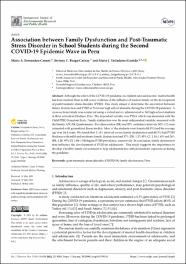Association between Family Dysfunction and Post-Traumatic Stress Disorder in School Students during the Second COVID-19 Epidemic Wave in Peru

View/
Download
(application/pdf: 672.2Kb)
(application/pdf: 672.2Kb)
Date
2022-07-30Author(s)
Fernandez-Canani, Maria A.
Burga-Cachay, Stefany C.
Valladares-Garrido, Mario J.
Metadata
Show full item recordAbstract
“Although the effect of the COVID-19 pandemic on children and adolescents’ mental health
has been studied, there is still scarce evidence of the influence of nuclear family on the development
of post-traumatic stress disorder (PTSD). This study aimed to determine the association between
family dysfunction and PTSD in Peruvian high-school students during the COVID-19 pandemic. A
cross-sectional study was conducted using a virtual survey administered to 562 high-school students
in three schools in Chiclayo, Peru. The dependent variable was PTSD, which was measured with the
Child PTSD Symptom Scale. Family dysfunction was the main independent variable, measured with
the Family APGAR Questionnaire. Prevalence ratios (PR) and 95% confidence intervals (95% CI) were
estimated with generalized linear models. Most of the students were female (88.3%) and the average
age was 14.4 years. We found that 21.4% showed severe family dysfunction and 60.3% had PTSD.
Students with mild and moderate family dysfunction had 37% (PR: 1.37; 95% CI: 1.14–1.65) and 26%
(PR: 1.26; 95% CI: 1.04–1.54) higher PTSD prevalence, respectively. In conclusion, family dysfunction
may influence the development of PTSD in adolescents. This study suggests the importance to
develop a healthy family environment to help adolescents face critical situations experienced during
the pandemic“
Collections
- Web of Science (WOS) [236]

